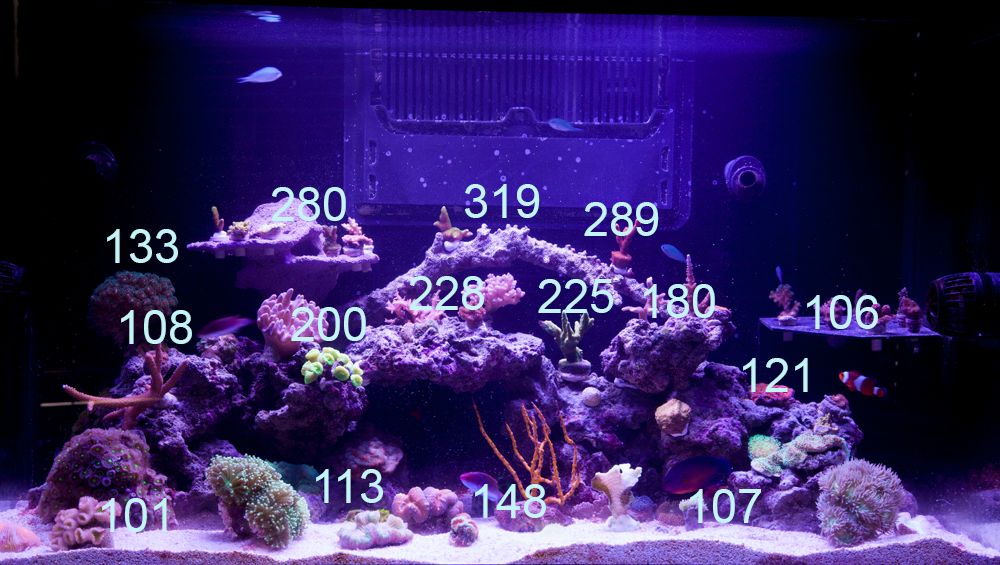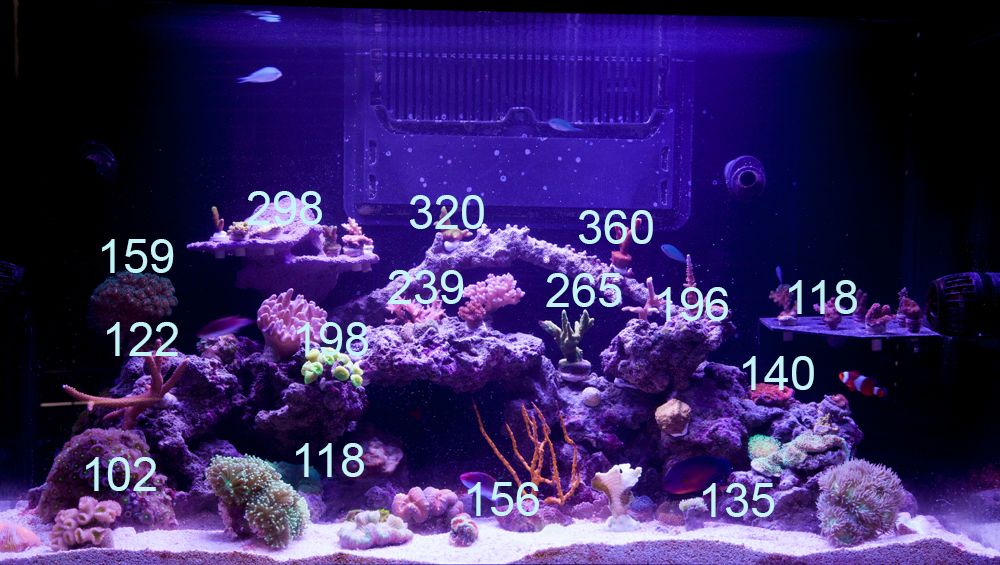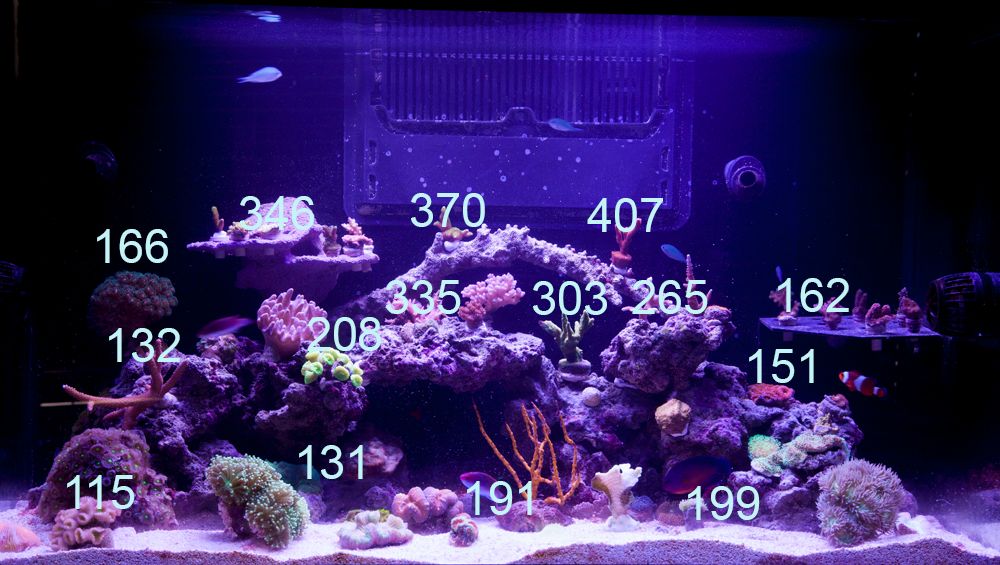Here's a bit of information that we have found regarding the PAR readings in our RSM250 LED upgrade.
Background: Photosynthetic Active Radiation (PAR). This is measured in units of micro-mol per meter squared per second (umol/m2/s), a measure of energy output, within the wavelengths of 400nm-800nm, which is traditionally called Photosynthetic Photon Flux Density (PPFD, but we won't use that latter term here, but just know they are one in the same).
PAR meters, which use quantum sensors (all PAR meters use quantum sensors) are not an accurate way to measure the PAR output of LEDs. Measuring PAR for LEDs is a bit more difficult than measuring broad spectrum lighting such as MH, T5, HPS, for which the PAR meter sensor was designed. A standard PAR meter works great for those broad spectrum sources, but not for narrow spectrum LEDs. (Yes full spectrum LEDs still are narrow spectrum, because they have bands near all of the phtosynthetic peaks on coral chlorophyll, which is why they are more efficient when trying to hit target wavelengths (think rifle bullet vs shotgun) and LEDs grow corals better).
A properly designed marine LED system uses LEDs with wavelengths that are aimed at very narrow and specific coral zooxanthellae's photosynthetic peaks in massive amounts - this quickly saturates a standard PAR meter's sensor. When the sensor is saturated, it cannot read that amount of light once it passes the saturation threshold, so the sensor retards the reading to a lesser false value.
The proper tool for measurement would be the radio-spectrometer. This type of tool reads specific bands and reports specific intensity readings for each wavelength. Whereas a PAR meter will simply output one value for the entire visible light spectrum and you are not sure which wavelength has the most intensity, and which wavelengths are are saturated.
When running a radio-spectrometer side by side with a relatively high end PAR meter, we have found that PAR meters are consistently reading about 30% lower than the actual value in the 445nm range (that's royal blue, or 20,000-24,000K actinic blue folks!), the most important range for coral since that's where the primary alpha (α) photosynthetic peak lays. It also gets saturated in the 460nm (regular cool blue), 430nm (violet) and 520nm (green) wavelengths as well, but to a lesser degree of about 12% reduction. We found negligible saturation (<5%) in the amber (600-700nm) and red (640-680nm) ranges too. These tests were performed on the Philips Luxeon Rebel and Philips Luxeon ES series LEDs. We can expect other high-end LEDs to perform similarly, whereas the no-name chinese LEDs (Epistar, Bridgelux, etc) perform at about 50%, or half as well, or about half as efficient dependent on the individual LED.
That said, marine aquarium LED systems have a dominate ratio of blue 445nm wavelengths to other wavelengths by a factor of at least 2:1, and in some cases around 3:1 depending on the LED combination you have and how many royal blues there are compared to other colored LEDs. From this, we can deduce a relatively safe offset when using PAR meters, of approximately 23% (approximation of the average of the differences in the primary proportions of PAR meter saturation reduction values listed in the previous paragraph). That means, we can relatively accurately use a PAR meter to measure the output of LEDs, by simply adding this otherwise unread amount of PAR (due to that sensor saturation) - a factor of +23% to the PAR reading.
Example: (2 assumptions : 1) let us assume the water is 100% clear, because that's a whole other story on PAR readings, 2) let us assume the PAR meter sensor is set at 12" below the light source.) The PAR meter "Meter Reads" values below are imaginary numbers to be used exclusively for this example.
Metal Halide (broad spectrum source)-
Meter Reads : reads 350 umol/m2/s (that's what we call "350 PAR")
Actual PAR value: it is spot on at 350 umol/m2/s
T5 (broad spectrum source)-
Meter Reads: Reads 350 umol/m2/s
Actual PAR Value: it is spot on at 350 umol/m2/s
LEDs (narrow spectrum source)-
Meter Reads: Reads 350 umol/m2/s
Actual PAR Value: we need to first account for our factor of 23% for PAR meter saturation to calculate the exact value (when using Luxeon LEDs):
350 umol/m2/s X (23%) = 80.50 umol/m2/s.
Now that we have that missing 23% value, we add it on to the original meter's value.
350 umol/m2/s + 80.50 umol/m2/s = 430.50 umol/m2/s
So based on the values read on the first post on this thread, you can add an additional 23% for a surprisingly accurate readout of actual PAR values, and you can then see that you can grow darn near any coral from any ocean, placed pretty much anywhere in the aquarium. The test to calculate the offset was considered a premium sensor, so it is likely more accurate and has a higher saturation tolerance than a lower quality meter, so the calculated value of 23% could be as high as 45%, depending on the quality level of the quantum sensor your PAR meter is using.
Let me know if anyone has additional questions, I'll be glad to explain.
Thanks,
Jeff









 Glad you joined in!
Glad you joined in! 